Our tall, green friends need just as much care as their smaller counterparts. Nurture and protect the health of your trees by being on the lookout for tree pests. Arm yourself with the necessary information on the life cycle and the symptoms of some of Ontario’s tree-threatening insects and diseases. The sooner you are able to succeed in the identification of these Ontario bugs, the less damage will be done to your trees, and the less you need to spend on treatment.
In a previous article, we discussed 4 of the most common tree pests in Ontario; below are 4 more you need to watch out for:
Anthracnose
Caused by the fungus Aureobasidium apocryptum and other species of Gloeosporium, anthracnose is a leaf blight that usually afflicts nearly all maple species, no matter how big or how old. Sugar maple seems to be the most susceptible to it. Besides maple, other tree species such as ash, basswood, ironwood, oak, and sycamore may also be infected by the fungus.
The fungus begins spreading in early spring mostly through spores from dead, infected, overwintered leaves. Cool, wet, and cloudy spring weather that lasts well into June is the ideal condition for the fungus to thrive.
What to Look Out For
You can spot the first symptoms in mid-May. The fungus may continue spreading throughout the growing season. Infected leaves have light brown spots and blotches around the main veins and the leaf margins. These may curl up, wither, and fall unusually early. Miniscule, cream-coloured spores grow mainly on the bottom face of the leaf, along the main veins, and occasionally, along the smaller ones.
Anthracnose exhibits similar characteristics to leaf scorch caused by unfavourable environmental conditions, such as intense heat, dry winds, and dry soil. You can distinguish anthracnose from leaf scorch by looking for the spores described above.
Treatment
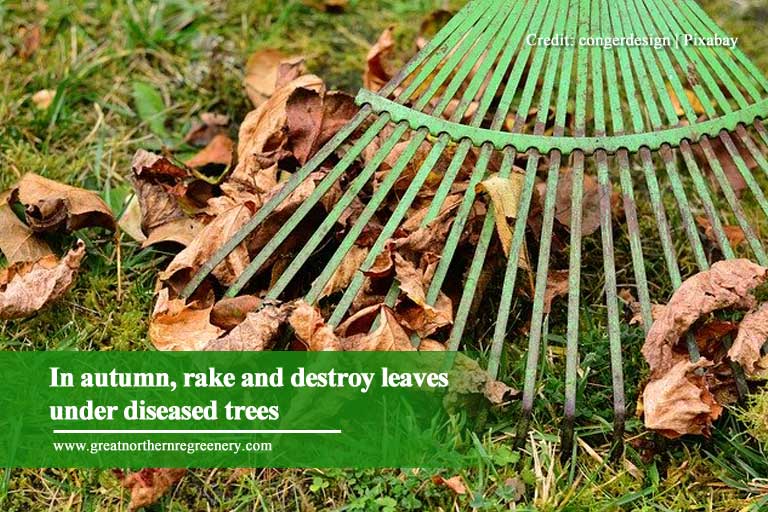
- In autumn, rake and destroy leaves under diseased trees.
- Root feed trees that have been severely diseased for many consecutive years. Root feeding is a method of fertilization. Holes are bored around a tree’s trunk, and liquid or powder fertilizer is placed into the holes to facilitate the plant’s absorption of the fertilizer.
- You don’t usually have to use sprays. If needed, spray thrice with zineb or ferbam during bud break (the period in a tree’s life cycle following dormant season, when buds open and develop into foliage). After bud break, spray twice every two weeks.
Black Knot
Black Knot is a fungal disease caused by Apiosporina morbosa. Trees of the genus Prunus, such as cherry and plum, are especially susceptible to it. Apricot, flowering almond, and peach may also catch this disease.
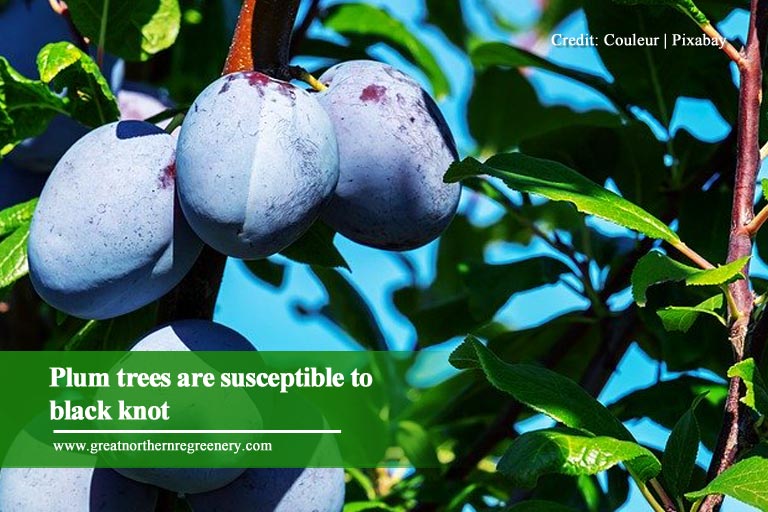
What to Look out For
The fungus begins to grow and infects wounds in the bark of newly grown twigs. In the next year, the infected parts will produce hard, rough, black knots. These usually grow thick, around 15 centimetres long on one side of the infected twig. However, they can sometimes cover the entire twig. The fungus will expand into branches and finally, the trunk, where it will inflict a large wound on the bark, usually with spiral fissures.
A layer of soft, olive-green spores will cover the knots in spring. These spores can be carried through the air and cause further infection to trees within a considerable distance of the diseased tree. The infected tree may still live even if it is overtaken by knots, but the disease will greatly reduce the aesthetic and commercial value of the tree.
Treatment
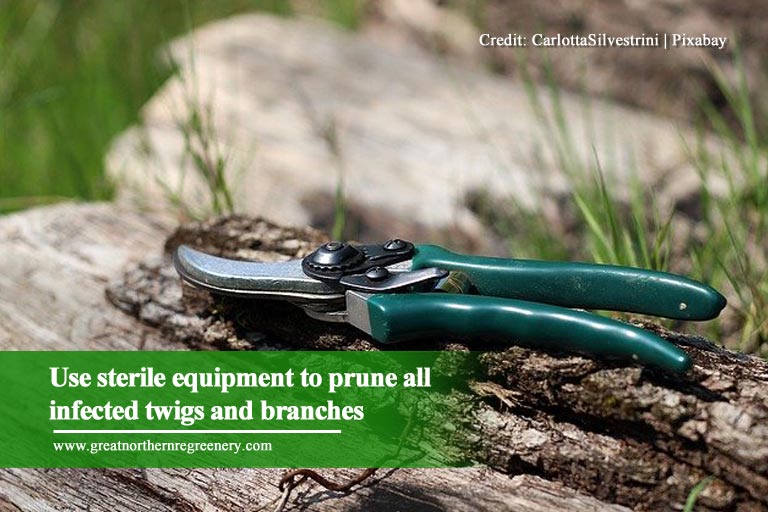
- In the dormant season, use sterile equipment to prune all infected twigs and branches. Make sure to start cutting many centimetres away from the knots. Destroy and discard all cut material.
- When a tree is completely overtaken by the fungus, it is best to chop down and destroy the entire tree.
Emerald Ash Borer
Emerald ash borer is an invasive beetle species that has been spotted in Detroit, Michigan, and Windsor, Ontario areas since 2002. It is likely that they have been in the area since the 1990s. Entomologists presume that the species was brought into the area from parts of Asia through wooden packaging or crates.
As its name indicates, the adult emerald ash borer is bright green and bores into wood. They can grow 8 to 14 millimetres long and 3 to 3.5 millimetres wide. Its body is long and its head, flat. The section of the abdomen under the wings is usually bright red.
Its pupa can be 10 to 15 millimetres long, cream coloured at first, and turns bright green as it matures.
Its larva is also cream coloured with a brown head and a flat body. The larva’s abdomen is divided into 10 segments with a fork-like appendage on one end.
Adult emerald ash borers lay eggs in the cracks of the tree bark or under bark scales during the summer. Out of the eggs, larvae bore into the bark where they carve out galleries and remain throughout the winter. They pupate in the early spring and mature later in the season. The fully developed beetles chomp through the bark and exit the tree, creating D-shaped holes.
This tree-threatening insect has proved to be fatal to many species of North American ash, such as black ash, green ash, pumpkin ash, Oregon ash, and white ash.
What to Look out For
- Crown dieback (the decline of the upper, outer branches of the tree)
- Misshapen bark
- Woodpecker feeding holes
- D-shaped holes in the trunk left by the fully developed beetle when it emerges from the tree in spring or summer
- Epicormic branches (new shoots indicating stress or damage) growing all over the tree instead of the lower trunk
- Yellow leaves
- Perpendicular fissures in the trunk
Treatment
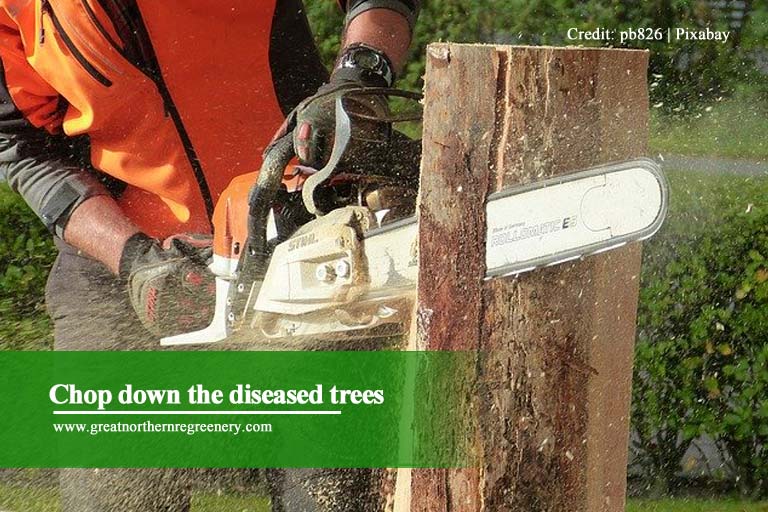
- If the infested site is small, you can chop down the diseased trees and burn or bury the wood.
- Use injectable insecticides before or as soon as you detect infestation and during spring or summer when the fully developed beetles emerge from the tree. Full recovery from the infestation may take long, sometimes years. You can repeat this treatment to prevent reinfestation.
- Or you can leave it to the experts, and hire a trusted tree insect control service provider.
Tar Spot
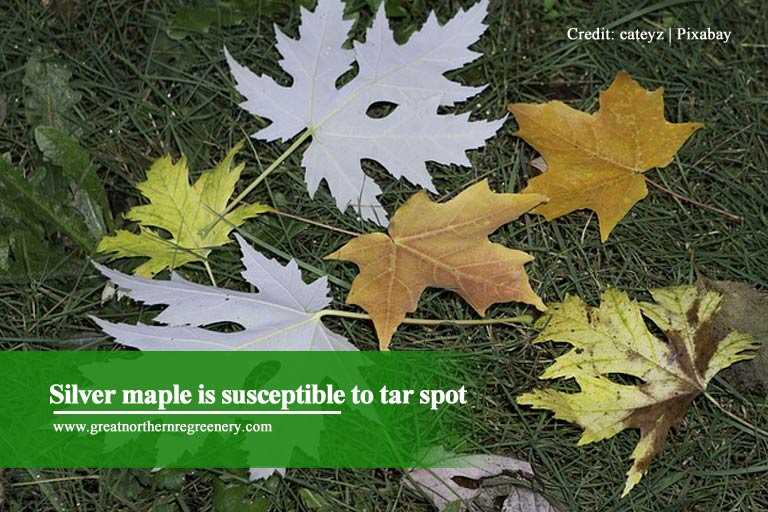
Tar spot is a fungal disease caused by Rhytisma acerinum. As you can tell by its name, the disease is recognized by ridged, dark spots on the leaves. Silver maple is especially susceptible to it.
What to Look out For
In early summer, yellow spots will begin to appear on the leaf. These will develop into darker, tar-like, about half-inch-wide spots later into the season. Upon close examination, the spots will appear raised, and the bottom surface of the leaf that is under the spot will appear curved.
The tar-like spot is the fungus’s fruiting body that holds its spores. The fungus survives the winter clinging onto dead leaves on the ground. Later in spring, the tar-like spots will release spores, which then become airborne, landing on newly growing leaves.
Treatment
Luckily, tar spot is not a fatal disease to trees, although this may cause some leaves to fall prematurely. Raking and destroying dead leaves can help prevent the spreading of the fungus. Fungicides are also commercially available but are not usually necessary.
If battling these tree-threatening insects and diseases seem daunting to you or if you simply don’t have the time to make the necessary treatments, don’t be afraid to ask for expert aid. Great Northern ReGreenery provides a variety of tree care services, including disease control and tree removal. Give us a call at (905) 775-7444 or email us at Regreenery@GreatNorthernRegreenery.com.





